HISTORY OF JULIANA JOHANNAH DORTEA CHRISTENSEN IVERSON
by her daughter ANNIE IVERSON WHIPPLE
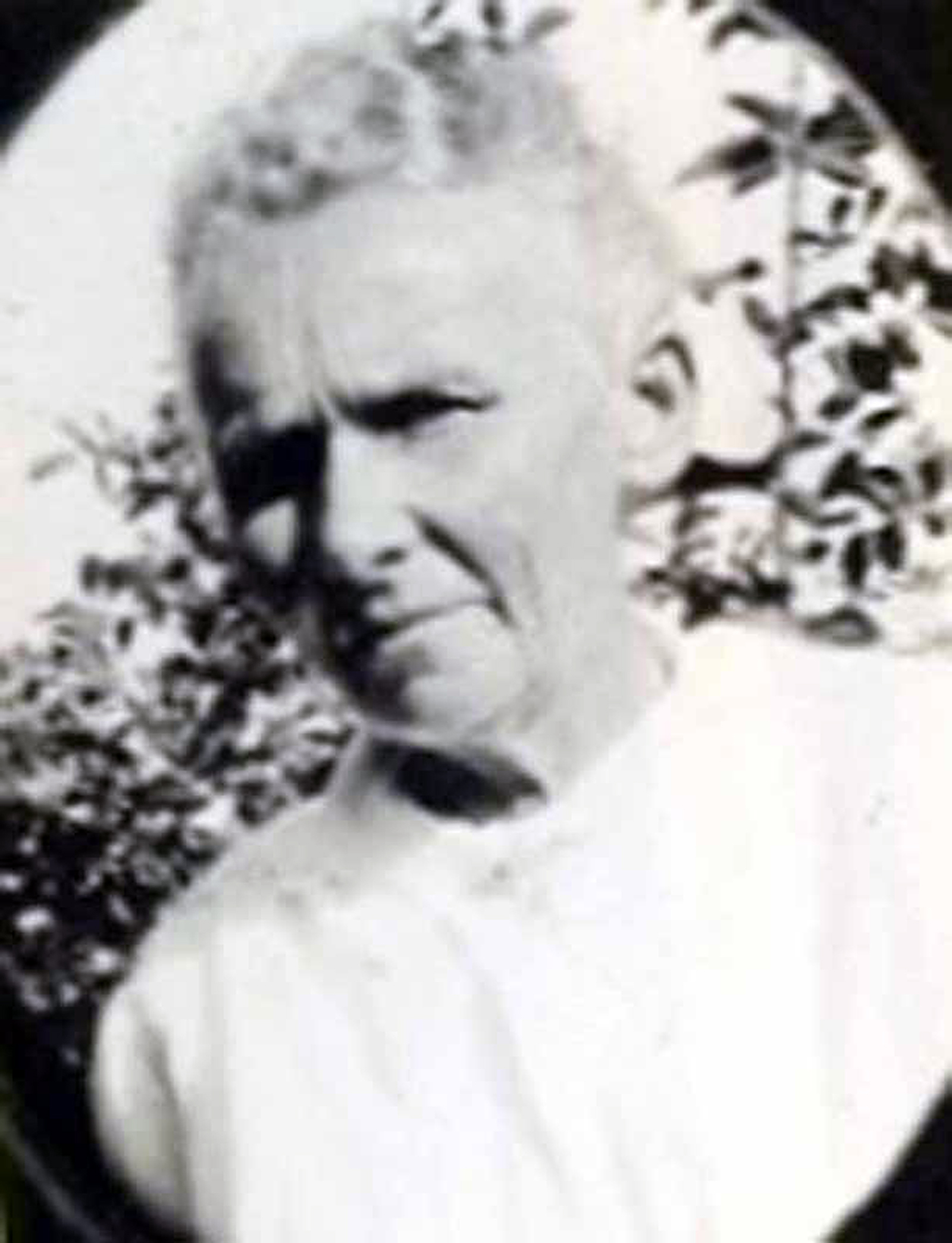 Juliane Johanne Dorthea Christensen
Juliane Johanne Dorthea Christensen
Juliana Johannah Dortea Christensen was the daughter of Jens and Larsina Maria Fredriksen Christensen. She was born in Aalborg, Denmark February 6, 1859, in Kjettrup Parish, according to Danish records and her own statements.
Johannah had four sisters, Matilda, the eldest, and Susannah, the youngest being born in Hals. Juliana Johannah, the second, was born in Oogaard, Hauhaart, Aalborg, and the third, Johanne Elisabet Ursula in Augaard, Kjettrup. These names and places are all found in Danish records. Jensine, the fourth, was born in Sundby, Aalborg. She died in 1878.
Johannah said that her mother had very poor health and spent a lot of time in bed, and that on washday her father would put a tub of water by the bed and she would do the washing. Her high strung, nervous father would walk the floor with the crying baby, finally tossing it on the bed. The family was so poor they could not afford much milk, so even the children drank coffee with a little milk or cream in it. Beer was a common drink in Denmark since the water was salty, as they lived near the ocean: They made their own beer, wetting barley and allowing it to sprout, then laying it out to dry. After grinding it they added hops.
When Johannah was young they lived near an army post and she and her sisters would watch the soldiers drill. This was when Denmark was at war with Germany. The soldiers were kind to them and sometimes put the child on their shoulders and marched sometimes giving her a coin.. She thought a lot of them.
Denmark was a green country in spring and summer, and little blue flowers grew wild. When she was older she sometimes dreamed she was back there with her family and picking flowers.
When eight years of age the family moved to Haals where her father worked in a big blacksmith shop where machinery was run by water power. Her job was to tend a huge hammer so it would not run too fast. The man who held the metal to be hit by the hammer would motion with his head to let her know how he wanted the hammer run. One job was
to help grind knives on a wooden wheel. There were cracks in this wheel and if the knife got too near the edge, it would be jerked out of the hand of the one holding it. One night, the men had finished and gone to supper, leaving her alone. Afraid, because of the ghost
stories the men sometimes told, Johannah tried to hurry. The knife got caught in one of the cracks and jerked through her hand, cutting it badly. She was very brave when being sewed up. And this ended her work in the blacksmith shop. Her fingers were crooked for the rest of her life as a result of this.
Her schooling consisted mainly of going to the priest to study the Catechism. Thus she became well versed in Bible stories. The family belonged to the Lutheran Church.
At the time she became a member of the Mormon Church, the family lived near the ocean, or North Sea, and this was where she was baptized, March 25, 1877. It was so cold that the ice had to be cut, and after being immersed she ran home with her clothes freezing around her.
While quite young, Hannah went to work for a Madam Sink, tending little Christian Sink. She often told how he was dressed in red velvet like a prince. Another not so fine story about him was that he was reluctant to use his potty chair and Hannah would have to entertain him in order to keep him there. His mother was a very good housekeeper, and if Johannah missed any dust, she would hear about it: The kettles were of brass and had to be scoured until they shone after every use. She also had to help the men do the work in the field.
The days were long in this land of the midnight sun, and the cows had to be milked three times a day since they were on green pasture. So while the men ate their dinner and took a nap, she would milk the cows. Then if any food was left she could have dinner in time to go back to the fields.
It was very cold in Denmark in the winter, and she would get wet wading through the snow. But it was so beautiful in other seasons that she always desired to go back for a visit and taste once more the tender, crisp vegetables that grew there. Turr was a form of soft coal, and that was what they burned to heat and cook with. She had to help cut it into blocks and turn it to dry day after day until she became very round shouldered. Binding and load ing grain contributed to this also..
At midnight it was so light that one could see to read out of doors. The midnight sun could be seen in winter and the nights were like twilight. The cows were only milked twice a day then, but there was wool carding to do, and spinning and plucking goose feathers for pillows and mattresses. They did not make quilts, but used feather ticks. Hannah brought one of them with her to America, and still had it when she died.
There were big brick ovens where people went to bake their bread, cakes, etc., in the country areas. The nearest city was Aalborg where they went to shop. It was quite rainy at times, and they loved to go into the woods where tents were pitched for picknickers. They could always keep dry in the tents. The sun would soon come out again.
The Christiansens lived mostly in apartment houses, similar to today's condominiums though of course not as nice. Being poor, they all had to eat from the same dish in the middle of the table. The children had to go to work as soon as they were old enough.
Hannah knew the Gospel was true the first time that she heard it. Still she hesitated, feeling that her friends would forsake her if she joined such an unpopular sect. After baptism, her one desire was to come to America where she hoped for an easier life. But had she known how hard her life would be, she would have come anyway with the kind of faith she possessed. She did not know that her future was already arranged: But it was very true that fate (or the Lord)had already arranged her future.
Hans Peter Iverson was one of the missionaries who had taught the Gospel to the family. Hannah had always liked and admired him, but she had never thought of becoming his wife. She did not know that he had been advised to take a sister home with him.
Hannah and her parents were present when the missionary gave his farewell address. He said later that he heard a voice telling him to take her home with him. After meeting, he handed her a note asking her to go home to Utah with him and saying he would wait outside for her answer. She aid not have long to think it over; but she felt that America would allow her children to have better lives and she would be with the Saints. So she told the missionary that she would have to find someone to take her place. To her surprise Brother Iverson said that he would do it for her.
Hannah knew that she must tell her parents and pack for the trip. Her folks knew that the missionary had a wife in Utah and feared that she might not welcome another woman into her home. But Hannah knew that the Lord would see her through. So she sailed with Hans Peter from Denmark to England and on to New York.
Hans Peter was a poor sailor and was in bed most of the trip. Hannah was only sick once and spent most of the daylight hours walking on the deck, which was a block or more long. There were quite a few Danish people on board, and one young man would tease her about marrying an "old" man. Hans Peter was 42. She could have married the young man, it seems, but she had given her word.
Hannah was a beautiful blond with long curly hair and a fair skin. She was about five feet tall. Partly due to her humped back.
While on the ship she heard the first American speak and thought it sounded outlandish. She also experienced a storm at sea. When the ship would roll, tin cups and plates the emigrants had with them would fly from one end to the other. The voyage took six weeks, and there was quite a lot of sickness aboard. Hannah was very glad to see land.
Hannah had never seen tomatoes nor peaches in Denmark and she was very disappointed when she bit into the bright red tomato for the first time. She learned to like them later on.
They rode the train from New York to Salt Lake, and here they got to go to Church, though she was disappointed in not getting to see Brigham Young. It was by team and wagon that they went on to St. George, taking Dora Evers along. She was a German girl who would also marry Hans Peter, though she may not have known it then.
In Washington, Hannah was taken to spend the night at the home of Jeppe Iverson, Hans Peter's father, while Hans Peter stayed with his wife Anna and their children.. An old lady in Washington told later, that she had heard the group singing "Come, come, ye Saints" as they had neared Washington.
Later on, Hannah lived with Aunt Annie, the first wife, and found her to be very kind. She gave her consent to her husband's marrying a second wife, and Hannah And Hans Peter were sealed in the new St. George Temple on August 10, l877.
Hans Peter was sealed to Dora Evers on January 10, 1878, and soon after moved the two younger wives into a home by themselves two miles out of Washington at a place called the Duck Farm. Here they learned to adjust and get along together. Dora had been raised in the city and knew nothing about farm work, so it fell to Hannah's lot to work in the fields and milk the cows. She also learned to chop the tough cottonwood to burn in the stove. It was in Washington that her first child, Julie, was born in 1878. She died three years later with Hannah holding her all night in the dark room, since there was no light. She died of yellow jaundice just two months before Peter Martin was born.
Because of polygamous persecution, Hans Peter and many others went into hiding. While her husband was in Colorado, Hannah had a very serious sick spell, malaria, due to a mosquito bite. Her body swelled up and she had a very high fever, alternated with chills. She mould hardly walk and people thought she would die. But a new medicine, Indian Root pills caused the water build up to leave and she recovered.
Tired of hiding out and of living by himself, Hans Peter came back and gave himself up to the. U. S. Marshals. He served six months in the penitentiary in Provo, then was released for good behavior. But he knew that he would have to take his polygamous families where they would be safe from the Law. This was Littlefield, Arizona.
With three children, Martin, Willard and Doretta and another child soon due, Hannah arrived in the little Swiss village across the line in an adjoining state. Here she lived in a one room lumber shack on a hill top.. When the new baby arrived June 24, 1891, she named him Victor, perhaps hoping that they would be victorious over their troubles. But it was not to be. It was so hot that an egg would fry in the sand, and all the water had to be carried in a bucket from a ditch below the hill. Hans Peter acquired a lot at the foot of the hill and built a dugout there. It was warmer in winter and cooler in summer.. But there were problems. The room was so small that the cook stove had to stand outside. So Hans P. built a brush shade over it. But it was right next to the ditch, where the road passed. So the roof had to be raised whenever a wagon came along to allow it to pass beneath. Levi, her sixth child was born in this dugout.
A homestead was taken up across the river, and it took a lot of hard work to get the land ready for planting. Ten year old Martin and his mother worked side by side doing this.
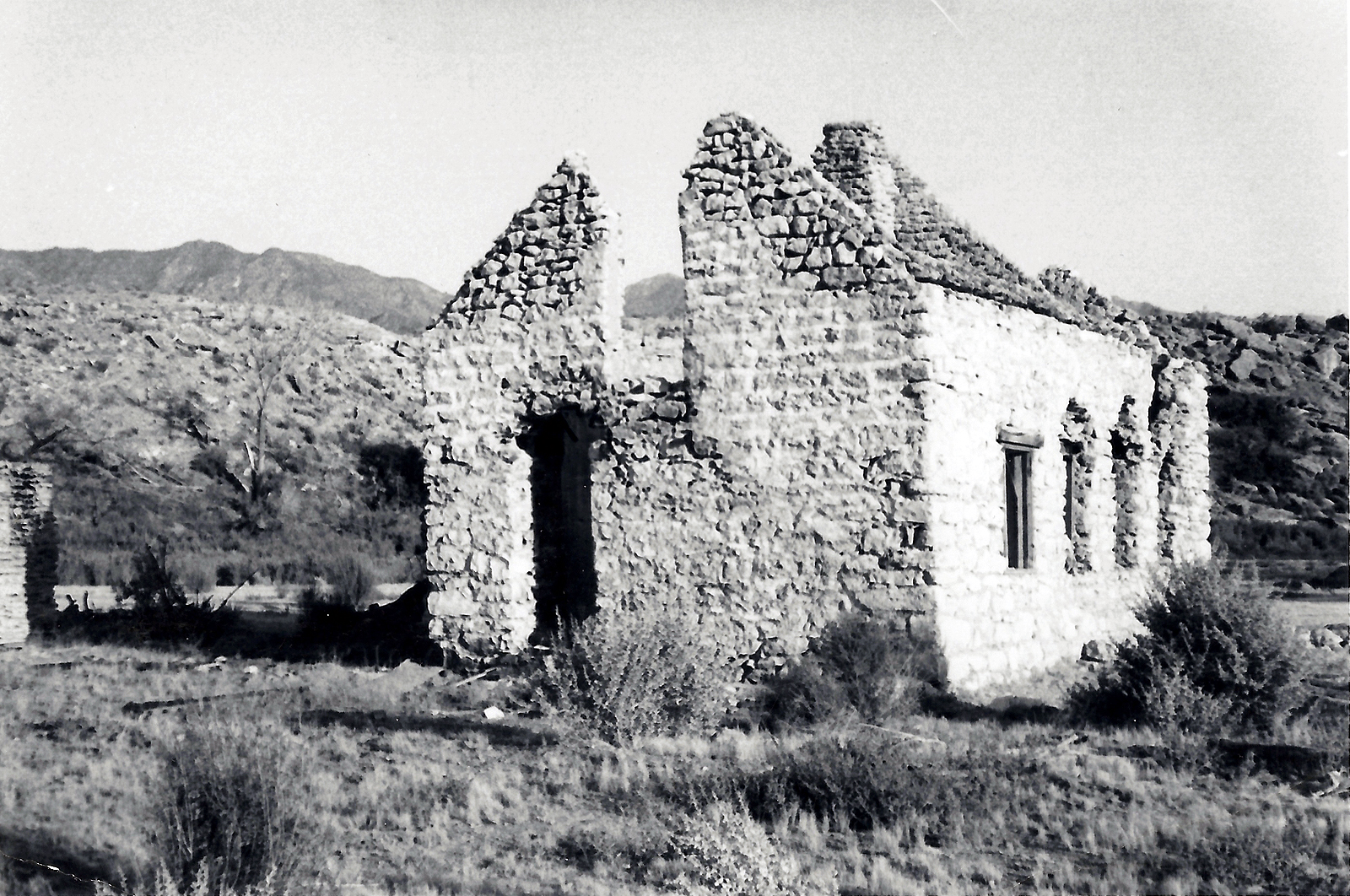 Ruins of the house in Littlefield
Ruins of the house in Littlefield
Finally, a lot was leveled across the ditch, and here Hans Peter built a new rock house. Only one room at first, later a kitchen and a cellar were added.. Here I, Annie, was born January 26, 1897.
In the lot by the house they planted all kinds of fruit trees and grape vines. And Hannah raised vegetables to compare with the ones she remembered in Denmark..And her husband went to Washington often to take care of his families there. Aunt Annie, the first wife, told him, however, that now her family was raised it was his duty to take care of his young families.
Hans Peter was a rock mason and helped build houses in Bunkerville and elsewhere in order to earn a little much needed money. The new house soon had a front porch and a lumber bedroom for the boys added to it. Life was beginning to be easier for the family.
Hans Peter decided to move Dora, the third wife, to Littlefield also that he might have all of them closer together. But he needed money in order to build her a home. So he moved Dora in with his father Jeppe, sold the Duck Farm at Washington, and began to build. All the children helped and soon the new home was ready to be lived in. It was about a block north of Hannah's house.
They had a corral and a stack yard for the hay and for the grain to be threshed in the fall. It was hard work for the men when the crew came to thresh, and also for the women, since huge meals had to be prepared for the workers. Hannah was a very good cook, and killed chickens and cleaned them, baked bread, pies and cakes, although she had never seen a pie before coming to America. They had milk, butter, vegetables and fruit, too, and everyone liked to eat at her table. She made preach preserves from their own molasses.
After Dora came to Littlefield, the two women would visit back and forth and the children enjoyed each other's company. Hannah was President of the small Primary at Littlefield and also had the duty of sitting up with the dead and putting wet cloths on them, since their was no ice available nor refrigeration.
One year typhoid hit the town and Doretta, Willard and Levi got it, Pneumonia accompanying the dread disease in some cases. Eddie Reber and Henry Frehner, two young men died of it, a sad occurrence in the small community.
In 1891 a family named Bundy moved to nearby Beaver Dams. This was an exciting event for the Iversons, since this meant new friends and, eventually, young folks to attend the dances and find romantic attachments with. Doretta Iverson married Roy Bundy in 1908. Martin Iverson having married Lillie Bundy a few years earlier. In 1906 Father Abraham Bundy took his family to the Mormon Colonies in Old Mexico, since floods in the Virgin River and Beaver Dam Wash had washed away the land he had been farming. The three older Iverson offspring also moved south of the border.
In September, 1910, a big flood came down the river, overflowing its banks and putting a coat of red mud in Dora's house, and on the fields, taking stack yards, livestock, fruit trees and all on which they depended for a livelihood. In .December a second one came, ruining what little the first flood had left. It was too much for the seventy one year old Hans Peter. He told Hannah to go to her children in Mexico. So she went to work at a dairy in a place called Grass Valley, making cheese and butter and doing clean up chores. Levi drove a team and scraper at the same place. It took several months, but she finally had enough to pay their passage to Mexico. But that winter they lived under the roof of their house, which Hans Peter had moved to his land across the river, while Dora lived in a tent.
Hannah had two pigs, twenty turkeys, and four cows to sell for a total of $80.00. Bedding, a trunk full of clothes, and a sewing machine was all she had to take. They took the train at Moapa, Nevada and went to Douglas, Arizona, where Doretta's husband, Roy Bundy met them and took them on to Colonia Moreles.
They had left Littlefield in December of 1911 just a year after the devastating flood that had driven them away. And Doretta's family did not even have a pine tree for their Christmas tree, but had improvised by bringing in a small cottonwood with yellow leaves still in place. This was something fourteen year old Annie would always remember. What the gifts may have been we do not know.
Hannah found work in different peoples homes for the next two or more years, but when Pancho Villa began rampaging the Mormons were advised to leave by the Church authorities. So it was back to the United States, this time in a wagon. Roy Bundy's family left the colonies too, but he had been working at the E1 Tigre mine up in the mountains and stayd behind to take care of their property as best he could. When he left he traveled by night to avoid the Mexicans, and had bullets whistle near his head on his way north.
The United States Government offered to pay part of the fare to the place the refugees wished to go so they were able to ride on the train from Douglas, Arizona to Moapa. Hans Peter was able to find employment for her at the Gentry Hotel at St. Thomas, Nevada. Here her skill at cooking meat, bread rolls, pastries, etc., made the railroad men yell happily when they came in to eat at the hotel. We do not know how long she worked there.
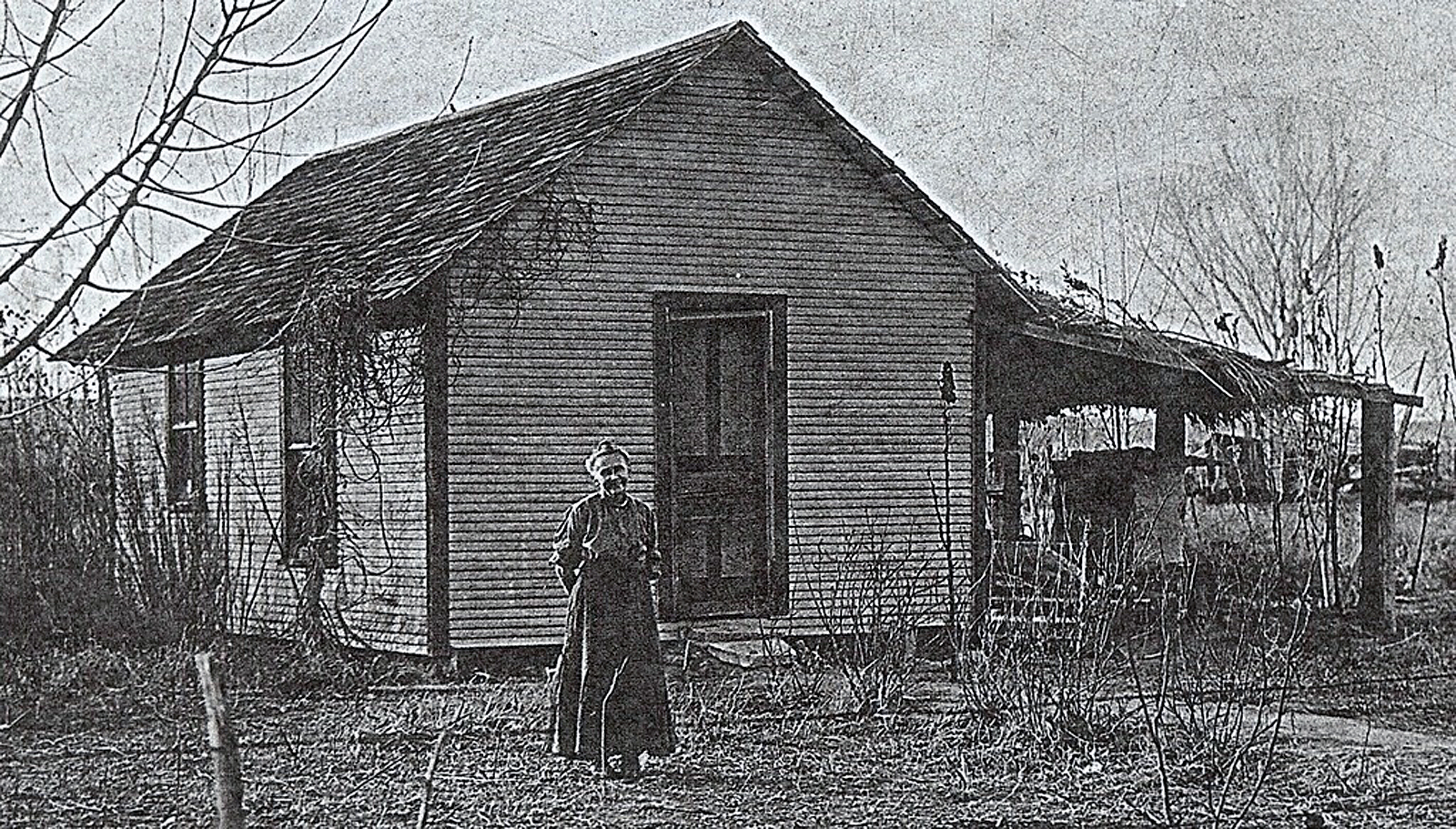 Hannah in front to her home in Kaolin
Hannah in front to her home in Kaolin
About six miles north of St. Thomas the Mormon Church owned a tract of land called Kaolin because of the clay of that name in the vicinity. They were selling and leasing this land, so Levi bought, acquired some of it along with a two room lumber building. Here he and Annie and their mother lived for about five years, except when different ones of them were off working.
Hannah had a terrible sick spell while at Kaolin, and a Dr. Beal said she had heart trouble and gave her a little white pill. A mouse helped himself to water from a glass containing a piece of the pill and next morning lay there dead.
Desiring to get her three sisters living in Mt. Pleasant to go to the Temple and be sealed to their parents, she made a trip north. She had been there at the death of her mother sometime before this. But because of illness and other reasons she did not accomplish this, but she did enjoy visiting her sisters. Temple work was done for all of them later on.
Kaolin was not a very profitable place for the Iversons, Bundys and others who had come from Old Mexico with them. So they decided to go out on the Arizona Strip and take up homesteads which the Government had just made available. The men had been out to investigate, and since the rainfall seemed adequate at the time they moved their families out. This was in 1917. However, no water at all was available at the place where they settled, so it was either necessary to haul water from a cattle ranch some thirteen miles distant or move to a small seep on the mountain side. Both of these life sustaining practices were put into use.
For Hannnah this last move was the worst of all. She had come to the homestead area by traveling up the steep, rocky, narrow Grand Gulch road. Ore was being hauled from the mine to the railroad at St. Thomas. And now she had reached a spot where water was scarcer than gold after a terrifying journey. At the little seep where Doretta was camping, gnats were so terrible that they nearly ate their faces. Cooking had to be done in a dutch oven over a camp fire.. They prayed that it would rain, and when it did, Levi took up a homestead two miles from Roy Bundy's. Here he pitched a tent for Hannah and Annie, and it was their home for some time.
A man named Fred Schultz had homesteaded west of what came to be known as "Bundyville," and later as "Mt. Trumbull." He owned a large flock of sheep and needed someone to cook for the shearers. He asked her to work for him as cook. He would buy a beef to feed his crew, and she would make bread and pies and the man were satisfied. Later on, she was asked to cook for the Schmutz and Blake sawmill crew. But there was not much to cook with so the men at the sawmill were not satisfied. All the men told the owners that she was a wonderful cook when she had something to cook with, so they brought more supplies from St. George and she did all right.
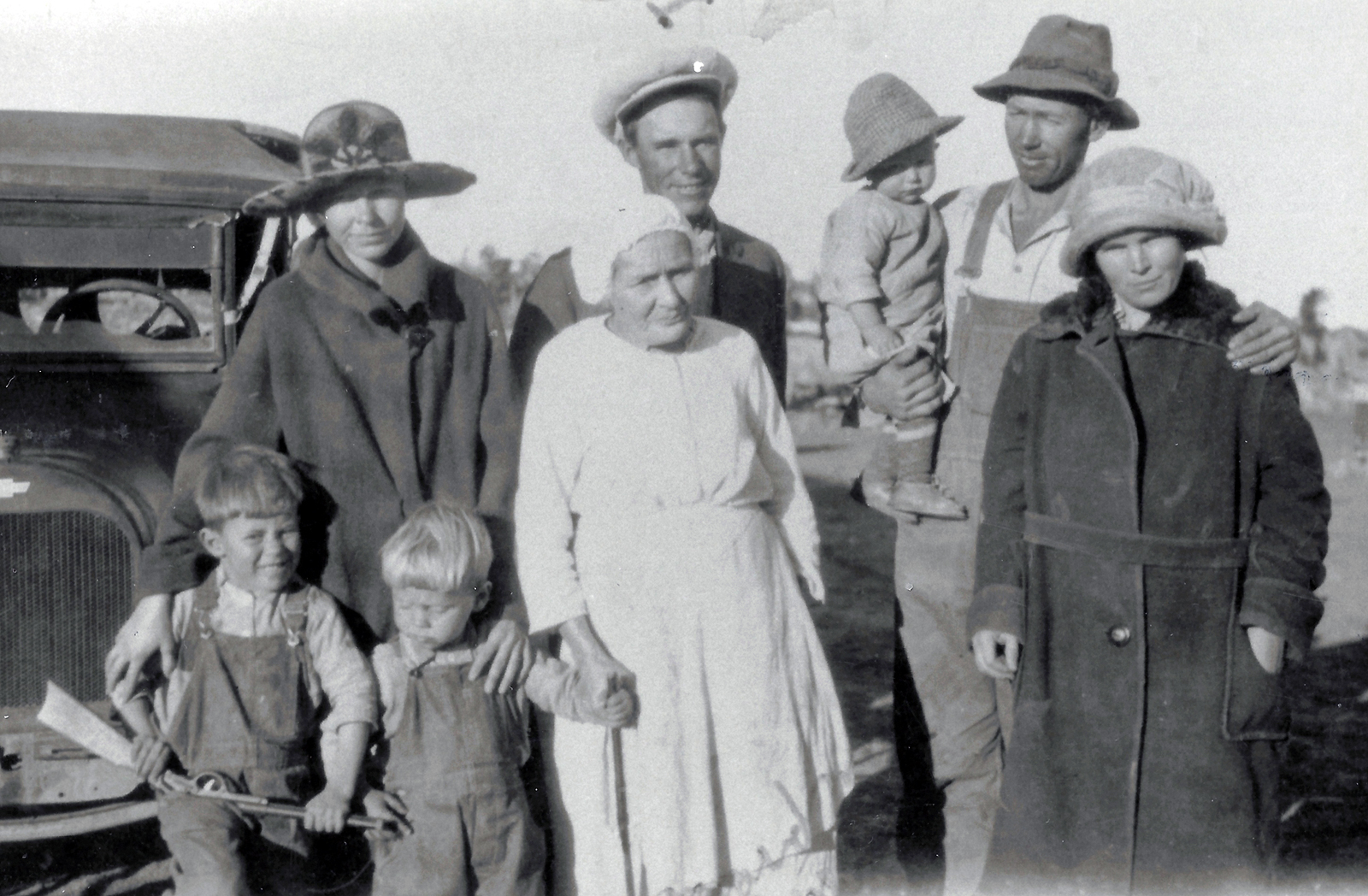 From the left Annie with two of her sons, Hannah with her son Victor behind
her and Hannah's son Levi with his wife Stella and their child
From the left Annie with two of her sons, Hannah with her son Victor behind
her and Hannah's son Levi with his wife Stella and their child
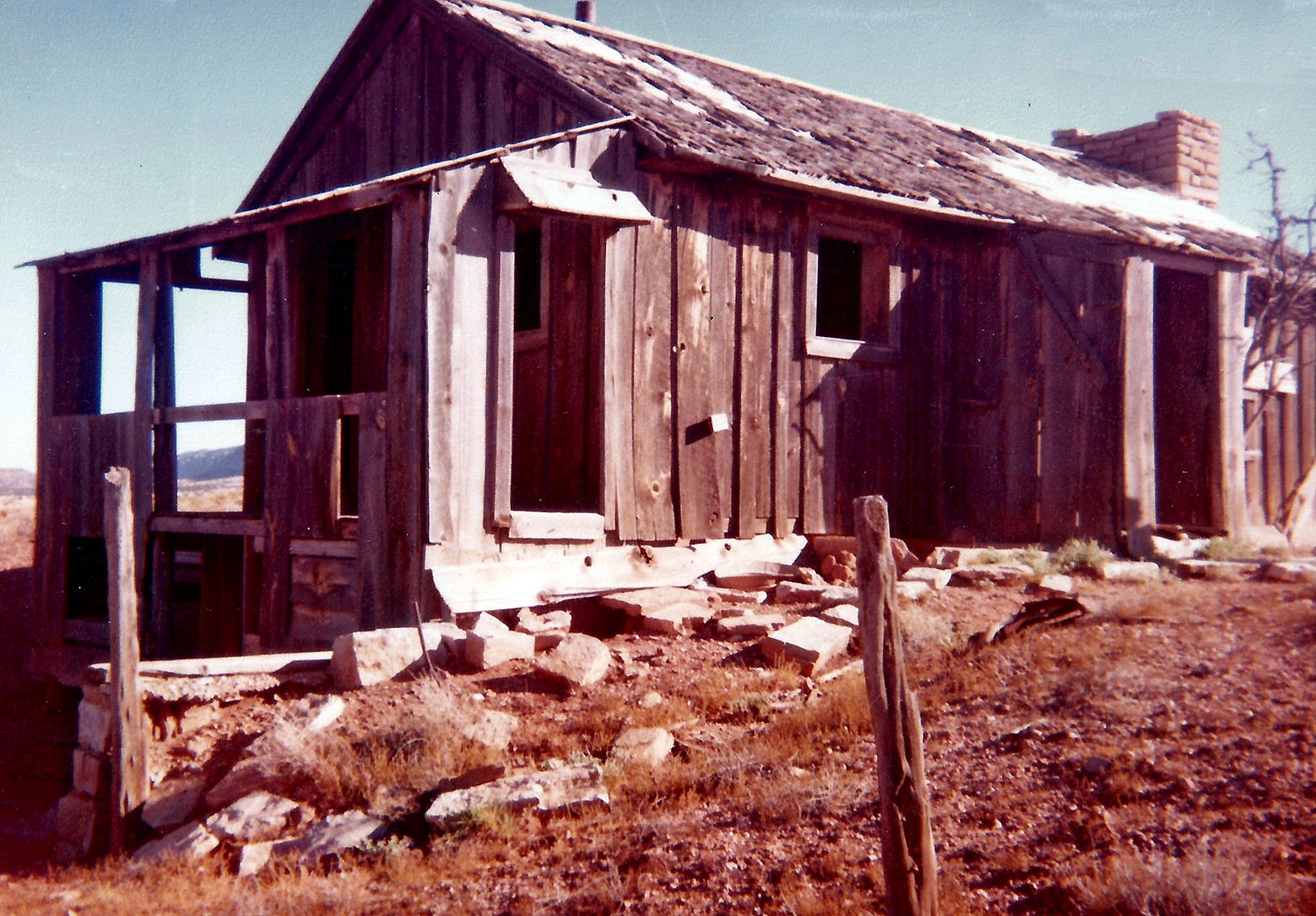 Hannah's and Willard's home in Mt Trumbull
Hannah's and Willard's home in Mt Trumbull
Hannah spent most of her time at the homestead taken up by her son Willard, homesteading a section adjoining his and near the homestead where Annie and her husband Roy Whipple lived. Here she carried water from the pond, often red with mud, and scrubbed on the board, helped different ones of her children, land otherwise occupied her time. After a few years she went in to St. George to work in the Temple, since Arizona at the time gave her a small amount of money, since she was a ,widow. A letter to Annie shows that she did not have enough to buy wood to keep her warm.. And Arizona stopped the money, since they said she was spending it in Utah. Where else could she have spent it? There were NO stores on the Strip where they lived, so it was either spend it in Utah or order everything from a catalogue.,
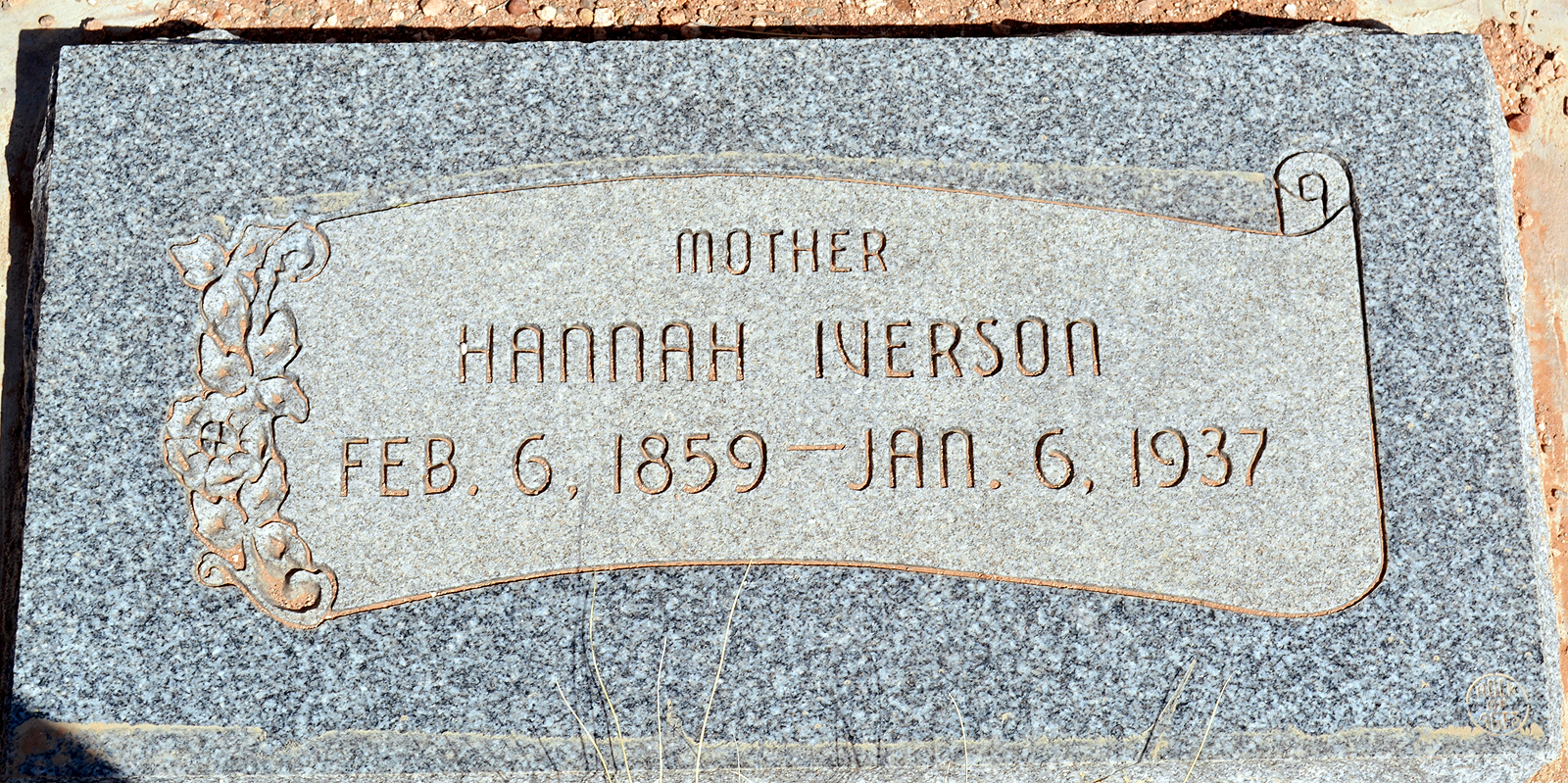
Listen to her grandson, Keith Iverson talk about her death and burial.
After twenty years at Mt. Trumbull, Hannah's health was far from good. She found it necessary to live with Doretta or Annie, and that was where she was when the Big Snow of 1936-37 hit. She had been sent to a doctor in St. George, but nothing seemed to help. And so it was that in a drafty little shack near Annie's place, up at a spot near the Bundyville schoolhouse, she became dangerously ill. The snow was so deep that wood to burn was very difficult to find, and though Annie and Bessie Bundy, her granddaughter, did all they could to keep her comfortable, it was impossible. She died January 6, 1937, and though her husband and tiny daughter were buried in Washington, Utah, it was impossible for a homemade sled and a team to get through. So she was buried three miles west of Bundyville schoolhouse at what came to be the regular cemetery on the old VanLeuven homestead. She was seventy seven, or would have been a month later.
The casket was made from scrap lumber by a man named Hez Welch, aided by Levi, Martin and Roy Whipple. The women lined it with cotton flannel. Martin fought through the snow to the burying place. She left six living children, 40 grandchildren and six or seven great grandchildren.
Hannah Christensen Iverson lived a life of service not only to her family, but to the departed spirits for whom she performed temple ordinances. We hope that all of them appreciate the hard life she lived and the work she did for others.
The following is a letter written by Juliana to her daughter Annie.
Dear Annie, I hate to tal you iem out of wood the otier nite a man cam en nock on de dor en I we to se whan he say he ask if i was Mrs. Iverson he hat som coel for me en i was suer glad i dot no wat i cut hav done is es suern coel in her. I am sorra dat Roy froys hes feet i hop de suen header. I sa Edna Greftde otter day. Se was alrit den Lester Buny hat a bat coel, isoe Victor last vick when i ferst cam en har he hat en offul sore fute he hat mast hes hick toe i havet hart sins. i we clos for des tiem vet must love thul f your motter Hannah Iverson.
Juliane Johanne Dorthea Christensen was born on 6 February, 1859. Family records list her birthplace as Aalborg, Denmark. I found a parish record that gave her birthplace as Kettrup, Vester Han, Thisted, Denmark.
She married Hans Peter Iverson 10 December, 1877 in the St. George Temple. She bore the following children with him.
As can be seen by this history her names are spelled many different ways, such as Juliane-Juliana, Johanne-Johannah, Dorthea-Dortea. Most people called her Hannah.
Laron Waite - 2017